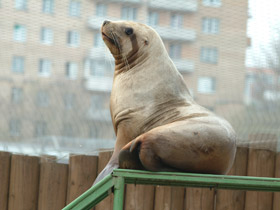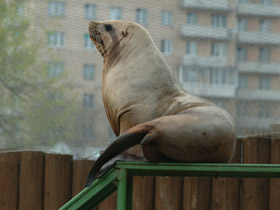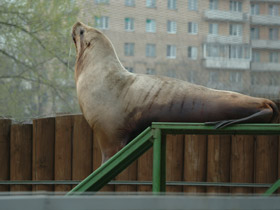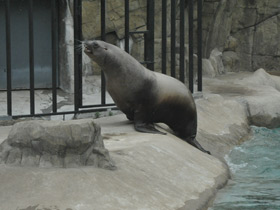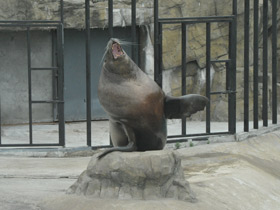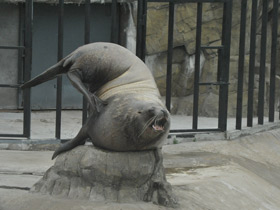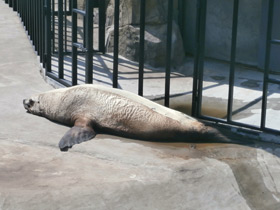Steller's sea lion (Eumetopias jubatus)
 Steller's sea lion (Eumetopias jubatus) is included in the Russian Red List
Steller's sea lion (Eumetopias jubatus) is included in the Russian Red List
The Steller sea lion (Eumetopias jubatus, also known as Steller's sea lion or the northern sea lion) is a large, near-threatened species of sea lion, predominantly found in the coastal marine habitats of the northeast Pacific Ocean and the Pacific Northwest regions of North America, from north-central California to Oregon, Washington and British Columbia to Alaska. Its range continues across the Northern Pacific and the Aleutian Islands, all the way to Kamchatka, Magadan Oblast, and the Sea of Okhotsk, south to Honshu’s northern coastline. It is the sole member of the genus Eumetopias, and the largest of the so-called eared seals (Otariidae). Among pinnipeds, only the walrus and the two species of elephant seal are bigger. The species is named for the naturalist and explorer Georg Wilhelm Steller, who first described them in 1741. Steller’s sea lions have attracted considerable attention in recent decades, both from scientists and the general public, due to significant (and largely unexplained) declines in their numbers over an extensive portion of their northern range—notably in Alaska.
Description
Eumetopias jubatus is a species of pinniped mammal in the otariid family.
Eumetopias jubatus is one of the largest pinnipeds and the largest of the long-eared seal family. An adult male is between 3.2 and 3.5 m long and its body mass varies between 500 and 1,120 kg; females are considerably smaller: their body length usually does not exceed 2.5 m and their mass averages 350 kg. Despite their large size and clumsy appearance on land, sea lions in the wild can climb high, almost sheer cliffs and jump ten metres into the water if threatened. The Eumetopias jubatus living in the Moscow Zoo also sometimes shows miracles of agility: it literally "flies" on a slide installed in its enclosure, and enjoys observing its surroundings from there (see photo).
Social behaviour and reproduction
In early spring, Eumetopias jubatus come ashore to breed and moult and form colonies, many of which have existed for centuries. Eumetopias jubatus appear in colonies in early May, with each colony attempting to occupy a particular territory, which is accompanied by constant fighting between suitors. The colony is occupied for 1.5-2.5 months, and they eat almost nothing during this time. In mid-May the females arrive and small harems begin to form (a male rarely has more than 12 females). Unlike other pinnipeds, male Eumetopias jubatus are not persistent in keeping females in their territory.
The female usually gives birth to a single large calf (twins are very rare), about one metre long (which is about half the length of the mother's body) and weighing 17-20 kg. Nursing of calves lasts one year, but often the bond between mother and calf lasts even longer. About 40% of Eumetopias jubatus females enter the colony with yearlings and continue to feed them even after the birth of a new brood.
Locomotion
The largest of the eared seals, Steller sea lions are quick swimmers, about as fast as the smaller California sea lions. Glide velocity of individual Steller sea lions has been measured as 2.9–3.4 meters or 1.2–1.5 body lengths per second, which is close to the optimal swim velocity of 1.4 body lengths per second based on the minimum cost of transport for California sea lions.
A 2007 study of Steller sea lions found that a majority of thrust was produced during the drive phase of the fore flipper stroke cycle. Although previous findings on eared seals suggested that thrust was generated by the initial outward movement of the foreflippers or the terminal drag-based paddling phase, the 2007 study found that little or no thrust was generated during those phases. Swimming performance in sea lions is modulated by changes in the duration and intensity of movements without changing their sequence. Using criteria based on velocity and the minimum radius of turns, Steller's maneuverability is similar to other eared seals, superior to cetaceans, and inferior to many fish.
Diving
To be able to dive for a long period of time, Steller sea lions exhibit apnea, bradycardia, and peripheral vasoconstriction. This allows them to maximize their oxygen stores and efficiently forage during their dives. In addition to those adaptations, their thick blubber layer and outer fur layer keep their body insulated during dives.
Trained Steller sea lions from Vancouver Aquarium were placed in the open ocean at the University of British Columbia's Open Water Research Station to study their diving metabolism and behavior. Steller sea lions' dives are more energetically costly if they perform dive bouts. The aerobic diving limit of Steller sea lions was observed to be affected by their nutritional state and feeding.
Communication
Like most otariids, Steller sea lions are vocal in air. Mature male sea lions have a range of vocalizations as part of their territorial behaviors, including belches, growls, snorts, and hisses that serve as warnings to others. Both males and females also produce underwater noises similar to their above water sounds, described as clicks, barks, and belches. The primary function of their vocalizations is for social behavior. Sonogram readings reported that Steller Sea Lions make discrete, low frequency pulses underwater that resemble the male "belching" territorial noise made in air. These underwater vocalizations have an average of 20–30 pulses per second.
Vocalizations are critical to mother-pup pairs, as the mothers must find their pups in a crowded breeding area when they return from foraging. The mother and pup both use distinctive calls, like names, to help differentiate themselves among the crowd of other sea lions. Their aerial vocalizations have been described as similar to the bleats of sheep, and bellows.
Because Steller sea lions are sexually dimorphic in size, their hearing differs in sensitivity, possibly due to differences in size of the hearing structures. Females have a higher sensitivity than males, perhaps to hear the higher frequency calls of their pups. The Steller sea lion's hearing range also suggests that they are capable of hearing the underwater calls of one of their main predators, the killer whale.
Nutrition
Adult Eumetopias jubatus feed on cephalopods and marine fish. To obtain food, they are able to dive to depths of more than 200m. Bearded and harbour seals sometimes eat fur and harbour seals.
Interactions with humans
Steller sea lion were hunted for meat and other commodities by prehistoric communities everywhere their range intersected with human communities. Aside from food and clothing, their skin was used to cover baidarkas and kayaks. A subsistence harvest on the order of 300 animals or less continues to this day in some native communities in Alaska.
Historically, the sea lion has had only very slight commercial value. For example, in the 19th century their whiskers sold for a penny apiece for use as tobacco-pipe cleaners.
Conservation status
Eumetopias jubatus is a relatively rare animal and is listed as "near threatened" on the IUCN Red List.










